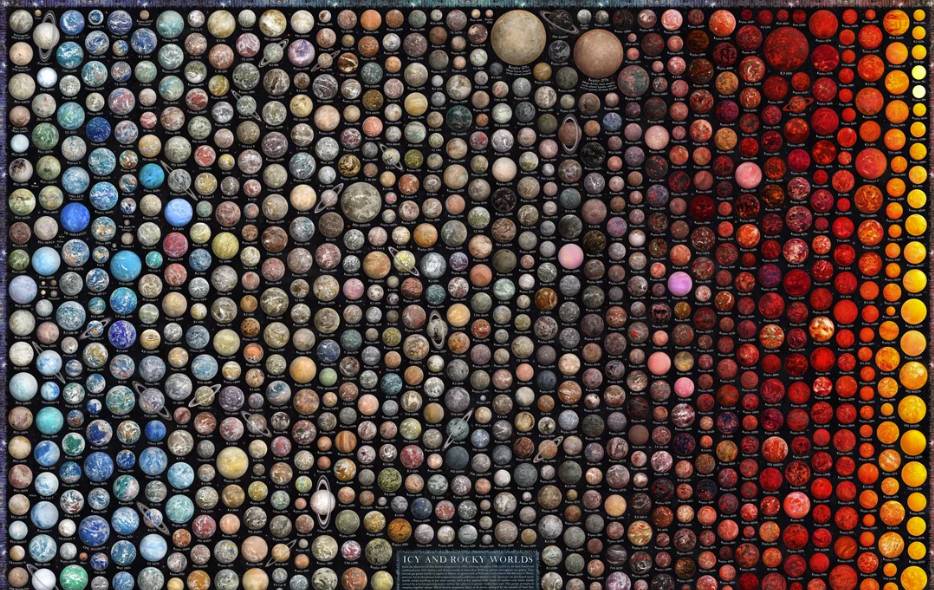Finding ExoLife
An exoplanet or extrasolar planet is a planet outside the Solar System. More than 5000 planets with a wide range of physical properties are now known. The first discovery of an exoplanet orbiting a solar-type star like our Sun was announced in 1995 by Michel Mayor and Didier Queloz. Both were awarded the Nobel Prize of Physics in 1995.
Detecting Signs of life: Biomarkers
One of the major challenges in the search for extraterrestrial life is determining how to recognize it when we find it. To address this issue, scientists rely on the concept of Biomarkers. Biomarkers are signs of life, such as the presence of specific gases in a planet’s atmosphere (e.g., oxygen, methane) or the detection of complex organic molecules.

Image credit: Halcyon Maps
A biomarker can be any kind of molecule indicating the existence, past or present, of living organisms. In the fields of astrobiology, biomarkers are also known as biosignatures. One of the major goals in astromomy is to detect biomarkers and molecules indicative of life with state-of-the-art instrumentation on upcoming extremely large telescopes.
5 Ways Astronomers Use to Detect Life Outside Earth
The last two decades have seen a remarkable revolution in exoplanet discovery, with powerful telescopes like the Kepler Space Telescope and the Transiting Exoplanet Survey Satellite (TESS) peering into the vastness of space.
These observatories have been pivotal in identifying thousands of exoplanets, ranging from massive gas giants to rocky, Earth-like worlds.
The data amassed from these missions provide astronomers with an ever-expanding catalogue of potential targets for the search for life. Some notable ways astronomer use to detect sign of lives outside Earth include:
The Goldilocks Zone: A Habitable Realm
One essential criterion for life as we know it is the presence of liquid water. To support life, exoplanets must lie within their star’s habitable zone, often referred to as the “Goldilocks zone.” This region is not too hot nor too cold, where conditions are just right for the existence of liquid water on the planet’s surface. Using telescopes, astronomers can identify exoplanets that orbit within this sweet spot, increasing the likelihood of potential habitability.
The Spectral Fingerprint: Bio-Signatures
When light from a star passes through an exoplanet’s atmosphere, it carries a spectral fingerprint that astronomers can analyze. The presence of certain molecules, such as water vapor, oxygen, methane, and carbon dioxide, can indicate the possibility of life on the planet.Telescopes equipped with spectrographs can detect these bio-signatures and provide valuable insights into an exoplanet’s atmospheric composition.
Direct Imaging: Capturing Exoplanets on Camera
Telescopes equipped with advanced adaptive optics can perform direct imaging of exoplanets by blocking out the overwhelming light of their parent stars. This technique allows astronomers to observe exoplanets and study their atmospheres, potentially identifying signs of life.Direct imaging is a challenging method, but as technology improves, it promises to reveal more about the distant worlds lurking in the depths of space.
The Transit Method: Watching for Tiny Dips
The transit method is one of the most effective ways to detect exoplanets and assess their atmospheres for signs of life. Telescopes monitor the brightness of distant stars, looking for slight dips caused by exoplanets passing in front of them.Analyzing the light passing through the exoplanet’s atmosphere during these transits can help astronomers gather valuable data about its composition and potential habitability.
Follow the Wobble: The Radial Velocity Technique
Telescopes equipped with high-precision spectrometers utilize the radial velocity technique to detect exoplanets by measuring the tiny wobbles induced in a star as it and its planets orbit their common center of mass. This method has been successful in finding numerous exoplanets and provides information about their mass and distance from the host star.Though not directly detecting bio-signatures, the radial velocity technique plays a critical role in determining which exoplanets are suitable for follow-up studies.
Neural Exo-Cartography
Detecting biosignatures through direct imaging requires the ability to identify features on the surface of exoplanets. To directly observe such features, we would need a telescope with a mirror hundreds of kilometers wide — something far beyond our current capabilities. However, there is an alternative: analyzing how the light reflected by the planet changes over time. From this light curve, it’s possible to reconstruct an approximate image of the planet’s surface.
This is a complex mathematical problem, so we use artificial intelligence trained on simulated planets —created using noise patterns inspired by Earth— to solve it. The AI learns to detect patterns using a technique called sparse regularization, which we apply in two ways: with convolutional layers on a pixelated map (HEALPix), and with spherical convolutional layers that also account for relationships between neighboring pixels.
This method is especially effective at reconstructing well-defined continents. When we tested it using Earth as if it were an exoplanet, we achieved accurate maps at moderate signal-to-noise ratios (SNR) of around ~10. Traditional methods would need signals ten times stronger to reach similar results.
Thanks to dedicated telescopes like SELF and ELF —the latter currently under construction at the Teide Observatory— achieving this level of precision will be entirely feasible. Combining these instruments with this neural exocartography approach opens the door to an exciting new era in the visual exploration of distant worlds.

Reconstruction of Earth as an exoplanet using light curves and deep learning. The image compares original and noisy data with two AI-based reconstructions, showing how neural techniques recover surface features like continents.
